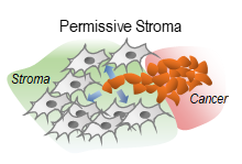
When we think of cancer, we mostly think of cells constituting the neoplastic part of cancer. But a cancerous lesion consists of many other cell types, which could resist, or help in its progression. These “stromal cells” consist of activated fibroblasts, macrophages, endothelial cells, as well as the specialized environment modulated by these cells. In our lab, we attempt to systematically understand how cancer and stromal cells interact with each other using a variety of approaches, including microfluidics, nanotechnology, live cell imaging, and genetic screens. We aim to elucidate the mechanisms through which stroma facilitates cancer to grow, become invasive, and resistant to chemotherapeutic drugs.
Communication between cancer cells and those in the stroma (consisting of cancer associated fibroblasts [CAFs], macrophages, other immune cells etc.) regulate many steps in the metastatic cascade, including initial dissemination, stromal invasion, tropism etc. These interactions, like all cellular phenotypes, are contextual and dynamic, bearing different kinetic profiles. These distinct secretory signatures could be interpreted specifically by the receiving cells to elicit a functional response. We use a variety of tools in our lab, including microfluidics, live cell imaging, and computational analysis to understand the nature of communication between cancer and stromal cells.
Related Publications
12. Afzal J±, Du W, Novin A, Liu Y, Wali K, Murthy A, Garen A, Wagner G, Kshitiz± (2022), Paracrine HB-EGF signaling reduce enhanced contractile and energetic state of activated decidual fibroblasts by rebalancing SRF-MRTF-TCF transcriptional axis, Frontiers in Cell and Development Biology, 10, 927361. ±: Corresponding Authors Article
11. Suhail Y, Maziarz JD, Novin A, Dighe A, Afzal J, Wagner G, Kshitiz (2022). Tracing the cis-regulatory changes underlying the endometrial control of placental invasion, Proceedings of the National Academy of Sciences of the United States of America,
10. Wagner GP, Kshitiz, Dighe A, Levchenko A (2022). The Coevolution of Placentation and Cancer, Annual Review of Animal Biosciences, 10. Article
9. Suhail Y, Afzal J, Kshitiz (2021). Evolved Resistance to Placental Invasion Secondarily Confers Increased Survival in Melanoma Patients, Journal of Clinical Medicine, 10(595). Article
8. Novin A, Suhail Y, Ajeti V, Goyal R, Wali K, Seck A, Jackson A, Kshitiz (2021). Diversity in cancer invasion phenotypes indicates specific stroma regulated programs, Human Cell, 34(1), 111-121. Article
7. Wagner G, Kshitiz, Levchenko A (2020). Comments on Boddy et al., 2020: Available data suggests positive relationship between placental invasion and malignancy, Evolution, Medicine, & Public Health, 1, 211-214. Article
6. Kshitiz±, Afzal J, Maziarz JD, Hamidzadeh A, Liang C, Erkenbrack EM, Ham H, Haeger, JD, Pfarrer C, Hoang T, Ott T, Spencer T, Pavlicev M, Antczak D, Levchenko A±, Wagner GP± (2019). The Evolution of Plancental Invasion and Cancer Metastasis are Causally Linked, Nature Ecology and Evolution 3, 1743-1753. ±: Corresponding Authors. Article
5. Yasir Suhail, Margo P. Cain, Kiran Vanaja, Paul A. Kurywchak, Andre Levchenko, Raghu Kalluri, Kshitiz# (2019), Systems Biology of Cancer Metastasis, Cell Systems, 9(2), 109-127. Article
4. Kim DH, Ewald AJ, Park JS, Kshitiz, Kwark M, Gray RS, Su CY, Seo J, An SS, Levchenko A (2018). Biomechanical interplay between anisotropic re-organization of cells and the surrounding matrix underlies transition to invasive cancer spread, Scientific Reports, 14210. Article
3. Kshitiz#*, Ellison DD*, Suhail Y*, Afzal J, Woo L, Kilic O, Spees J, Levchenko A# (2019). Dynamic secretome of bone marrow-derived stromal cells reveals a cardioprotective biochemical cocktail, Proceedings of the National Academy of Sciences USA. Article
2. Kshitiz, Afzal J*, Suhail Y*, Ahn EH, Goyal R, Hubbi ME, Hussaini Q, Ellison DD, Goyal J, Nacev B, Kim DH, Lee JH, Frankel S, Gray K, Bankoti R, Chien AJ, Levchenko A (2015). Control of the interface between heterotypic cell populations reveals the mechanism of intercellular transfer of signaling proteins, Integrative Biology, 7, 364-372. Article

